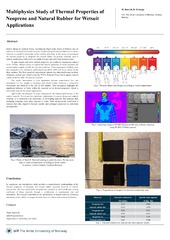| dc.description.abstract | Surfers daring the harshest waves, including the frigid arctic waters of Norway, rely on wetsuits for extended cold-water sessions. Understanding the thermal behavior of wetsuit materials is crucial for enhancing surfers' comfort and safety. In this study, we investigate the thermal properties of neoprene and natural rubber, the primary materials used in wetsuit construction, with a focus on conductive and convective heat transfer modes. To gain insights into these thermal properties, we conducted experiments using a FLIR T1030sc infrared camera to capture the thermal signatures of frozen neoprene and natural rubber samples in both dry and wet conditions. These experimental findings were then compared with simulations performed using MATLAB® and Ansys, based on the Heat equation. The Heat equation's approximate solution was discretized using the finite difference method and solved using the FTCS (Forward-Time-Central-Space) method within the MATLAB® software environment. Our results demonstrate a close agreement between experimental data and simulations for dry samples of neoprene and natural rubber. However, a noteworthy discrepancy was observed in the case of wet samples. This discrepancy highlights the significant influence of water within the material on its thermal properties, which is particularly relevant for wetsuit applications. Specifically, the presence of water compromises the thermal performance of the wetsuit material. This insight has significant implications for wetsuit design and material selection, as it underscores the importance of developing materials that maintain their insulating properties even when exposed to water. Such advancements could lead to wetsuits that offer improved thermal comfort and prolonged protection in cold-water environments. In conclusion, our multiphysics study provides a comprehensive understanding of the thermal properties of neoprene and natural rubber, essential materials in wetsuit construction. We have successfully estimated the conductivity and overall heat transfer coefficient of these materials through a combination of experimental data and simulations. This research contributes to the optimization of wetsuit materials, ultimately enhancing surfers' ability to conquer extreme waves in various cold-water environments. | en_US |


 English
English norsk
norsk